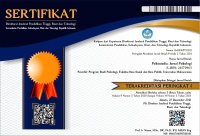Resiliensi Remaja Korban Bencana Alam Likuifaksi Di Desa Jono Oge Kecamatan Sigi Biromaru Provinsi Sulawesi Tengah
Abstract
Liquefaction natural disasters have an effect on the psychological condition of individuals, especially in adolescents, resilience becomes a very important part when a teenager is in a developmental stage, namely the existence of a state of happiness, satisfaction, low stress levels, physically and mentally healthy living life. With resilience after going through a traumatic event in their life, adolescents can rise to live aspects of their lives as teenagers. This study aims to determine and describe the resilience of adolescent victims of liquefaction natural disasters in Jono Oge Village, Sigi Biromaru District, Central Sulawesi Province. The participants in this study were two teenagers who survived a natural liquefaction disaster. The method in this study is a qualitative case study type method with data collection using observation, interviews and documentation. The results of the research on the two participants show that they are resilient individuals who are able to go through tough conditions so that they can recover from any events that cause stress and are able to adapt positively and survive these severe traumatic conditions. This is evidenced by the characteristics of the resilience aspects, namely emotion regulation, empathy, reaching out, impulse control, optimism, causal analysis, self-efficacy.
Bencana alam likuifaksi memberikan pengaruh pada kondisi psikologis individu terlebih khusus pada remaja, resiliensi menjadi bagian amat penting ketika seorang remaja dalam masa tahap perkembangan yakni adanya suatu keadaan rasa bahagia, kepuasan, tingkat stres yang rendah, sehat secara fisik dan mental menjalani kehidupan. Dengan adanya resiliensi setelah melalui peristiwa traumatis dalam hidupnya, remaja dapat bangkit untuk menjalani aspek-aspek kehidupannya sebagai seorang remaja. Penelitian ini bertujuan untuk mengetahui dan mendeskripsikan resiliensi pada remaja korban bencana alam likuifaksi di desa jono oge kecamatan sigi biromaru provinsi sulawesi tengah. Partisipan dalam penelitian ini adalah dua remaja yang selamat dari bencana alam likuifaksi. Metode dalam penelitian ini adalah metode kualitatif jenis studi kasus dengan pengumpulan data menggunakan observasi, wawancara dan dokumentasi. Hasil penelitian pada kedua partisipan menunjukkan mereka merupakan individu resilen yang mampu melewati kondisi yang berat sehingga bisa kembali pulih dari segala peristiwa yang menyebabkan tekanan dan mampu untuk menyesuaikan diri dengan positif dan bertahan dari kondisi traumatis yang berat tersebut. Sehingga penting untuk menjadi perhatian dalam meningkatkan kemampuan resiliensi bagi setiap orang untuk dapat bertahan disegala situasi yang sulit.
Keywords
Full Text:
FULL TEXTReferences
Aulia, L. A.-A., Kelly, E., & Zuhri, A. S. (2022). Dukungan Keluarga dalam Meningkatkan Motivasi Belajar Siswa. Psikotudia, 11(4), 623–632. https://doi.org/10.30872/psikostudia.v11i4
Campbell, L., & Stein, M. B. (2007). Psychometric Analys and Refinement of the Connor-Davidson Resilience Scale (CD-RISC): Validation of a 10-Item Measure of Resilience. Journal of Traumatic Stress, 20(3), 251–262. https://doi.org/10.1002/jts
Clauss-Ehlers, C. (2008). Sociocultural factors, resilience, and coping: Support for a culturally sensitive measure of resilience. Journal of Applied Developmental Psychology, 29(3), 197–212. https://doi.org/10.1016/j.appdev.2008.02.004
Connor, K. M., & Davidson, J. R. T. (2003). Development of a new Resilience scale: The Connor-Davidson Resilience Scale (CD-RISC). Depression and Anxiety, 18(2), 76–82. https://doi.org/10.1002/da.10113
Creswell, J., W. (2015). Penelitian Kualitatif & Desain Riset. Pustaka Pelajar.
Dina, O. (2012). Resiliensi Remaja Aceh Yang Mengalami Bencana Tsunami. Fakultas Psikologi Universitas Indonesia.
Everall, R. D., Allrows, K. J., & Paulson, B. L. (2006). Creating a future: A study of resilience in suicidal female adolescents. Journal of Counseling & Development, 84(4), 461–470.
Grotberg, E. (1995). A Guide To Promoting Resilience In Children: Strengthening The Human Spirit. Bernard van Leer Foundation.
Hidayat, D. (2008). Kesiapsiagaan Masyarakat : Paradigma Baru Pengelolaan Bencana Alam Di Indonesia. Jurnal Kependudukan Indonesia, 3(1), 69–84.
Kramer, S. (1996). Geotechnical Earthquake Engineering, Prentice Hall International Series, Englewood Cliffs, NJ. Washington.
Masna. (2013). Resiliensi Remaja Penyandang Tunanetra Pada SLB A Ruhui Rahayu Di Samarinda. Psikoborneo, 1(1), 28–32. http://dx.doi.org/10.30872/psikoborneo.v1i1.3275
Mirza, R., Sitorus, T. Y., Sitorus, A. R., Retta, C. T., Tarigan, N. B., & Nurhayani. (2022). Bagaimana Gambaran Proses Regulasi Emosi Pada Anak Yatim. Psikotudia, 11(4), 647–657. https://doi.org/http://dx.doi.org/10.30872/psikostudia.v11i4.9077
Muhammad, K. (2014). Hubungan Empati Dan Komunikasi Interpersonal Dengan Kualitas Hidup. Psikostudia, 3(1), 37–49. http://dx.doi.org/10.30872/psikostudia.v3i1.2245
Patton, M. Q. (2002). Qualitative Research & Evaluation Mehods (3 edition). Sage Publishing.
Rasyid, M., Saputri, S. A., Larasati, L. D., & Tanjung, A. A. R. R. P. (2018). Mirror Talk Sebagai Upaya Meningkatkan SelfCompassion. Psikostudia, 7(1), 22–31. http://dx.doi.org/10.30872/psikostudia.v7i1. 2390
Reivich, K., & Shatte. (2002). The Resiliency Factor : 7 Keys to Finding Your Inne Strength and Overcoming Life’s Hurdles. Broadway Book.
Ryff, C. D., & Keyes, C. L. (1995). The Structure of Psychological Well-Being. Journal of Personality and Social Psychology. Journal of Personality and Social Psychology, 69(4), 719–727. 10.1037/0022-3514.69.4.719
Santrock, J. W. (2003). Adolescence: Perkembangan Remaja (Edisi ke-6). Penerbit Erlangga.
Sarapang, Hanny, & Rogi. (2019). Analisis Kerentanan Bencana Tsunami Di Kota Palu. Jurnal Spasial, 6(2), 2442–3262.
Sarsito, D. A. (2010). Pemodelan Geometrik dan Kinematik Kawasan Sulawesi dan Kalimantan Bagian Timur berdasarkan Data GNSS-GPS dan Gaya Berat Global. In Disertasi. Bandung: Institut Teknologi Bandung.
Snyder, C. R., & Lopez, S. J. (2002). Hanbook of positive psychology. Oxford University Press.
Sugiura, M., & Abe, T. (2015). Eight Personal Characteristics Associated with the Power to Live with Disasters as Indicated by Survivors of the 2011 Great East Japan Earthquake Disaster. PLOS ONE, 10(7). https://doi.org/10.1371/journal.pone.0130349
Tazkiyah, A. Y. (2019). Resiliensi dan Post Traumatic Growth (PTG). Psikoborneo, 7(3), 383–393. http://dx.doi.org/10.30872/psikobor neo.v7i3.4796
Tugade, M. F. (2004). Psychological resilience and positive emotional granularity. Journal of Personality, 72(6), 1161–1190. 10.1111/j.1467-6494.2004.00294.x
Vijayakumar, L. T. (2006). Psychosocial interventions after tsunami in Tamil Nadu, India. Journal International Review of Psychiatry, 18(3), 225–231. 10.1080/09540260600655912
Wagnild, G., & Young, H. (1993). Development and psychometric evaluation of the resilience scale. Journal of Nursing Measurement, 1(2), 165–178. https://doi.org/10.1016/j.apnu.2010.05.001
Widiawati, A. (2017). Resiliensi Pada Remaja Yang Tinggal Di Daerah Rawan Bencana. Solo: Fakultas Psikologi Universitas Muhammadiyah Surakarta.
Wijaya, A. A., Setiawati, E., & Alfinuha. (2020). Menjadi Taruna Bahagia: Pelatihan Resiliensi untuk Meningkatkan Psychological Well-Being Taruna Akademi Angkatan Laut. Psikostudia, 9(2), 97–104.
Wijayanti, A. (2016). Strategi Coping Dan Subjective Well Baing Remaja Pasca Aborsi Di Samarinda. Psikoborneo, 4(2), 248–253. http://dx.doi.org/10.30872/psikoborneo.v4i2.4009
Wolin, S. J., & Wolin, S. (1993). The Resilient Self How Survivors of Trouble Families Arise Above Adversity. New York Villard Books.
Organization, W. H. (2012). Assessing mental health and psychosocial needs and resources toolkit for humanitarian settings. Geneva: World Health Organization.
Yustia, F. A., Lubis, H., & Putri, E. T. (2021). Sense of Humor dengan Subjective Well-Being Sense of Humor dengan Subjective Well-Being. Psikoborneo, 9(3), 566–574.
DOI: http://dx.doi.org/10.30872/psikostudia.v12i3.10952
Refbacks
- There are currently no refbacks.
Copyright (c) 2023 Psikostudia : Jurnal Psikologi

This work is licensed under a Creative Commons Attribution-ShareAlike 4.0 International License.
Psikostudia: Jurnal Psikologi is indexed by :
PSIKOSTUDIA: Jurnal Psikologi Published by Faculty of Social and Political Siences, University of Mulawarman, Samarinda, East Kalimantan and This work is licensed under a Creative Commons Attribution-ShareAlike 4.0 International License.
_________________________________________
PSIKOSTUDIA: Jurnal Psikologi
Department of Psychology
Faculty of Social and Political Siences, University of Mulawarman
Jl. Muara Muntai Kampus Gn. Kelua Samarinda 75411
Phone: +62 813 35350368
E-Mail: psikostudia@fisip.unmul.ac.id




















